Mobile app development, the Internet, and technology have enabled humanity to produce positive results and accomplish achievements faster than ever before. Unfortunately, as much as these new tools have augmented our ability to do good, they also allow us to do bad.
Wildlife crimes such as the illegal trade of ivory and other rare animal parts have flourished through these new technological avenues in recent years. Tech titans like Google and Facebook have taken notice, and now they’re teaming up to put a stop to these illicit activities.
An Old Evil, a New Avenue
It’s not unusual for people to have antiquated ideas of how illegal ivory or rhino horn trades are operated today. After all, it’s a topic that’s uncomfortable to discuss. Most people get this mental picture of these meetings and deals going down in shady store basements or backrooms.
But because of the anonymity offered and the ability to post numerous sale listings easily, the Internet has increasingly become the go-to marketplace for these dark affairs. And when one platform or marketplace begins to crack down on these deals, the sellers and buyers simply migrate to another host. It’s turned into a frustrating, endless game of ‘whack-a-mole.’
“Criminal groups and illegal traders are exploiting the technology to operate anonymously online with less chance of detection and to reach a wider market than ever before,” explains Crawford Allan. He’s the senior director of wildlife crime and traffic at the World Wildlife Fund (WWF) and TRAFFIC, an organization that monitors wildlife trade. Allan believes that law enforcement can’t handle the monumental task of policing the entire Internet. So he sought out the help of the Internet giants themselves.
The Wildlife Justice League
To stop the animal traffickers before they even begin, the WWF, TRAFFIC, and the International Fund for Animal Welfare have launched the Global Coalition to End Wildlife Trafficking Online. And this new coalition has been able to recruit quite a few friends, spanning the most famous San Francisco developers to the biggest e-commerce giants in China: eBay, Google, Etsy, Facebook, Alibaba, Baidu, Instagram, Microsoft, Pinterest, and Tencent, and many more have all signed up.

“The companies themselves were the obvious answer. If the companies can take down the ads before they’re even posted, we’re in good shape,” says Allan. “Bringing these industry giants together is the best shot at systematically closing the open web to wildlife traffickers.”
The coalition’s main objective is to reduce illicit wildlife product trades by a colossal 80 percent by 2020.
The Brink of Extinction
Technology has bolstered illegal wildlife trade to such an extent that many species are bordering closer to extinction than ever before. In 2007, thirteen rhinos were illegally killed for their horns. In 2017, this number surpassed a thousand. More than 20,000 African elephants are killed each year for their tusks. This trend has caused the Savanna elephant population to plummet by approximately 30 percent between the years of 2007 and 2014. This doesn’t even begin to scratch the surface for the damage done — other rare animals, from sea turtles and rare reptiles to tiger cubs, are all being killed for materialistic purposes.
While tech giants have been feeling pressure to police this issue for years, part of the problem rests in the ability to distinguish what’s aiding these illegal activities. For instance, countries like Japan and China (until just recently) allow ivory obtained legally to be traded domestically. This puts the issue of deciphering what’s ethical and unethical on potential buyers. Not only this but even when platforms ban certain words like ‘ivory,’ merchants devise a code word and proceed with business as usual.
Machine Learning to the Rescue
While each company involved in the coalition will pursue productive measures that are customized for their own platforms, one common tactic will be to employ algorithms and machine learning to flag suspicious posts and keywords before they’re made public. To boost the efficiency of this process, WWF will also be training teams at each company to manually review and evaluate flagged posts.
Allan would also like to get the platform users involved: “Another thing is getting users to become the eyes and ears of the company,” essentially “wildlife crime cyber-spotters who can report anything to the company that slipped through the automatic filters.”
Collaboration Is Key
The companies are also sharing their best practices with one another in order to rapidly improve their results. The fact that these companies, some of which are in direct competition with one another, can put aside their differences to solve this crucial problem gives Allan and many other wildlife advocates hope for the future.
“It’s their duty to do the right thing, but the way that the web is evolving, it’s very hard for everybody to keep up,” says Allan. “For them to take a stand on this, when they could take a stand on thousands of other issues, it’s heartwarming to see. The way the companies have embraced it has really been an eye-opener.”
We couldn’t be more excited by the efforts of these tech titans to protect animals around the world, and we’re rooting for them to reach their ambitious 2020 goal!







